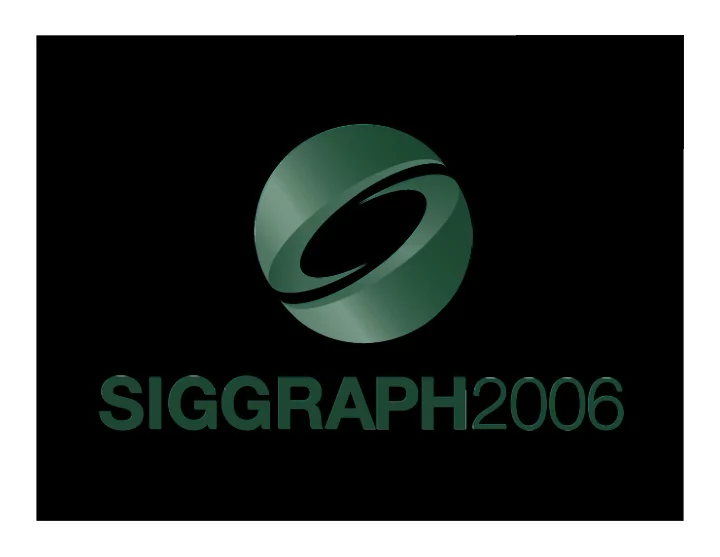

Massive Model Rendering with Super Computers Abe Stephens 1:30 - 1:50pm Speaker affiliations: SCI Institute, University of Utah and Intel Corporation.
Overview Focus on shared-memory/multi-core software design. • Massive models? Why use super computers? • Challenges: parallel build & rendering. • Manta architecture. • Applications & conclusions.
Massive Model Visualization • Hundreds of millions of primitives. • Scientific data, CAD, architectural. • Principle task is static inspection. Image/Data credits: James Bigler/CSAFE, SGI/Newport News Shipbuilding, Aaron Knoll/ LLNL, The Boeing Company. Rendered using Manta Ray Tracer.
Massive Model Visualization Double Eagle Tanker 85 M Triangles CSAFE Container 2.8 million particles 2.1 voxel volume 450 timesteps Boeing 777 350 M Triangles Richtmyer-Meshkov 8 GB volume 272 timesteps
Application Scenario • Quality Engineers use ray tracer to visualize problems with aircraft assembly. A. Stephens, S. Boulos, J. Bigler, I. Wald, and S. G. Parker An Application of Scalable Massive Model Interaction using Shared Memory Systems Proceedings of the Eurographics Symposium on Parallel Graphics and Visualization, 2006
Application Scenario
Why parallel computers? • Large amount of processors and memory. • The same system used for scientific computing and visualization. • Becoming smaller and cost less. • Faster multi-core clusters 16 core Opteron system. (top) require fewer nodes. 16 processor SGI Itanium (half rack).
Parallel Acceleration Structure Build • Example parallel KD-Tree build. – Strategies for offline build • Multi-thread sorting and merging. • Evaluate split candidates in parallel. • Build sub-trees in parallel. Reduced 777 build time from one day to several hours.
Parallel Ray Tracing • Easy to break ray tracing into parallel pieces. • Parallel architecture must focus on scalability. – User input coordination. – Thread safe state changes. – Display overhead. – Acceleration structure update. Processor utilization (green is unused capacity) • Both thread level parallelism and instruction level parallelism effect design.
Manta Software Architecture • Addresses both thread level parallelism and instruction stream optimization. • Provides a scalable foundation to solve a variety of rendering problems. • Modular software components and Python bindings. http://code.sci.utah.edu/Manta Open Source
Manta Parallel Pipeline Image Display Thread n Pipeline Barrier Ray Tracing . . . Thread 0 Frame Setup Transactions
Manta Parallel Pipeline Display of previous frame. Thread n . . . Thread 0 Ray tracing, dynamically load balanced.
Manta Parallel Pipeline Thread n . . . Thread 0
Manta Rendering Stack • Stack of modular sampling and ray tracing components. • Only global synchronization in pipeline. • Threads execute stack asynchronously. Renderer Pixel Sampler Image Traverser Thread n
Load balancing Load balancer tile division, requires thread safety.
Code Example void Pipeline::inner_loop( int frame, int proc, int numProcs ) { // Global synchronization. pipeline_barrier.waitFor( numProcs ); // Inherently load balanced. parallel_animation_callbacks(); // Imbalanced. if (proc == display_proc) image_display-> displayImage( buffer[frame-1] ); // Dynamically balanced. image_traverser-> render_image( buffer[frame], proc ); }
Code Example void Raytracer::traceRays(const Context& context, RayPacket& rays) { context.camera->makeRays(rays); RayPacket subPacket(rays, i, end); hit_matl->shade(context, subPacket); rays.resetHits(); i=end; context.scene->getObject()->intersect(context, } else { rays); int end = i+1; while(end < rays.end() && for(int i = rays.begin();i<rays.end();){ !rays.wasHit(end)) if(rays.wasHit(i)){ end++; const Material* hit_matl = RayPacket subPacket(rays, i, end); rays.getHitMaterial(i); context.scene->getBackground()- int end = i+1; >shade(context, while(end < rays.end() && rays.wasHit(end) subPacket); && i=end; rays.getHitMaterial(end) == hit_matl) } end++; } }
Scalability - 128 processors
Bottom Line • To achieve scalable multi-threadperformance: – Use a parallel pipeline with limited synchronization points. – Use asynchronous display. • Optimize for single processor performance. – Use packet properties for instruction optimization. • Not really “big iron” any more.
Questions? A. Stephens, S. Boulos, J. Bigler, I. Wald, and S. G. Parker An Application of Scalable Massive Model Interaction using Shared Memory Systems Proceedings of the Eurographics Symposium on Parallel Graphics and Visualization, 2006 A. Knoll, I. Wald, S. G. Parker, C. Hansen. Interactive Isosurface Ray Tracing of Large Octree Volumes. Scientific Computing and Imaging Institute, University of Utah. Technical Report No UUSCI-2006-026. (submitted) J. Bigler, A. Stephens, S. G. Parker. Design for Parallel Interactive Ray Tracing Systems. Scientific Computing and Imaging Institute, University of Utah. Technical Report No UUSCI-2006-027. (submitted) This work is supported by: • U.S. Department of Energy through the Center for the Simulation of Accidental Fires and Explosions, under grant W-7405-ENG-48 • Utah Center of Excellence for Interactive Ray-Tracing and Photo Realistic Visualization. • National Science Foundation. Additional support through internships: • Silicon Graphics Inc. • Intel Corporation
Recommend
More recommend